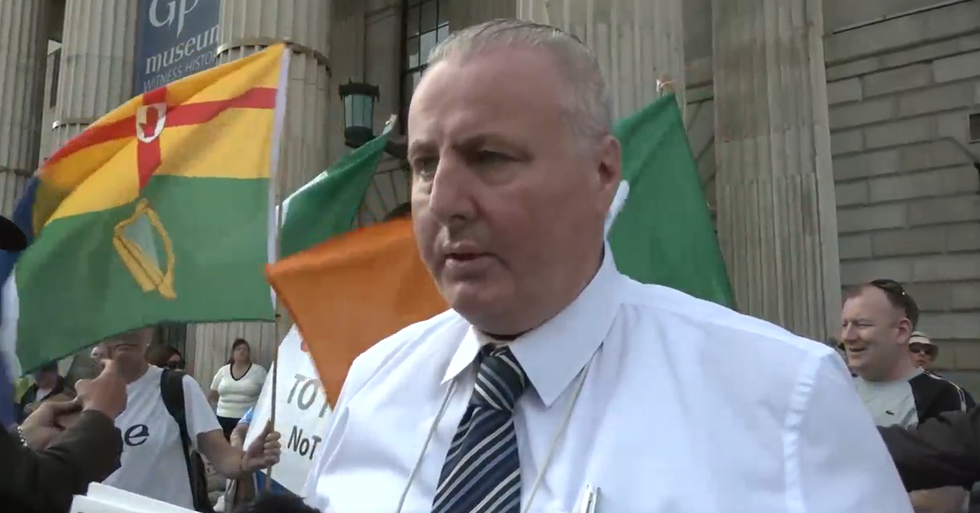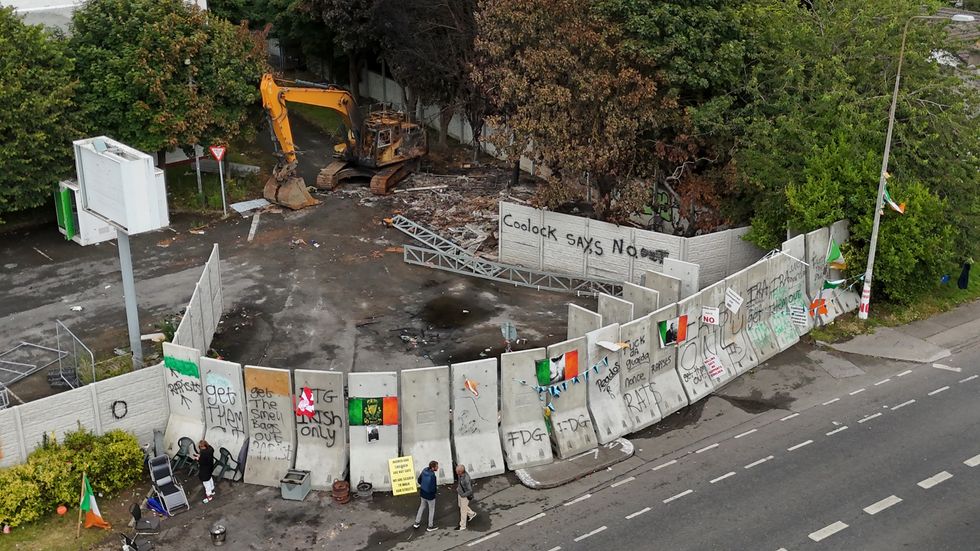People march through Dublin city centre during an anti-immigration protest
PA
Hundreds of protestors gathered in Dublin on Thursday to take part in an anti-immigration march
Don't Miss
Most Read
Trending on GB News
Hundreds of people gathered in the streets of Dublin on Thursday to take part in an anti-immigration protest.
People carrying Irish flags and banners stating, “You’ll never beat the Irish” and “Thornton Hall says no,” at the same time chanted “Whose streets? Our streets” and “Get them out, get them out.”
The protestors began by gathering outside the GPO in Dublin before marching through the city towards the Dáil and finally staging a sit-down protest on O’Connell Bridge in the afternoon.
Meanwhile, counter-protests took place at the junction of Dawson Street and Molesworth Street with participants loudly chanting “far right loyalists, get off our streets”.

Brian Garrigan said he was protesting on Thursday to "support the people of Ireland" and "look after our own people first"
GB News
Gardaí, including members of the public order unit were present at both protests which saw non-violent confrontations between the two groups earlier in the day.
Speaking to GB News at the protest, Brian Garrigan who is running in Dublin Bay North as an independent at the next general election said he was there to “support the people of Ireland” and to “look after our own people first.”
He continued: “Positive immigration is fantastic. People from Romania and from Poland coming in and putting their shoulders to the wheel... is no problem at all.
“The problem I do have is illegal immigration. At the moment we have 80 per cent of people coming down from Northern Ireland, being bussed down straight into the IPAS centre, being given a tent and a cent, who have failed their application in the UK...and that’s what I’m against.”
Another protestor commented: “We should be like Germany, close the borders.”
Commenting on the nature of the marches, Garrigan explained: “We are not violent. We do not throw anything.”
Unfortunately, over the past year, other anti-immigration protests have turned violent across Ireland over migrant housing plans.
In July this year, demonstrations took place at a former paint factory in Coolock after locals opposed its alleged repurposing into a site for asylum seekers.
In one protest, hundreds of demonstrators assembled at the site hurling abuse at the police and setting fire to mattresses.
Prior to the riots in Coolock, similar protests took place in Newtownmountkennedy in April and Tallaght in May.
In Newtownmountkennedy, East Wicklow, a fire broke out at a similar site expected to house asylum seekers in April.
The following month, a site in Tallaght, a Dublin suburb, was targeted by two pipe bomb attacks after the area was set to receive 350 asylum seekers.
The former Crown Paints site is just one of the 200 around the country designated for accommodating asylum applicants by the International Protection Accommodation Service (IPAS).
Some 400 people have been arriving in Ireland weekly since February seeking international protection, which is almost double last year’s figure.
This year a total of 25,000 people are expected to make applications for asylum bringing the total number since 2019 to 50,000.
Speaking on GB News, Irish political correspondent Ben Scallon claimed that immigration issues have been ongoing for "several years," due to the "grandiose commitment by government to having a no cap policy when it came to asylum seekers."
 Protestors around the former Crown Paints factory in Coolock PA
Protestors around the former Crown Paints factory in Coolock PALATEST FROM MEMBERSHIP:
- Get FIVE free entries to the Great British Giveaway when you become a GBN member in September
- Landlords face £90,000 capital gains tax bills - and 'brutal tax hike' fears is hitting tenants
- Listed: The top 10 MPs accepting gifts since 2019
Scallan explained: "They said we will take as many as they can effectively, and were bracing to accept as many as 200,000 asylum seekers entering Ireland.
"For those who don't know, the Republic of Ireland's population is just over five million. So 200,000 in a country with a population of that size is astonishing."
Communities feel like they simply cannot cope with an influx of newcomers as they battle housing shortages, rising fuel bills and a struggling economy.
One of Ireland's most acute crises is its housing emergency caused by a deficit of between 212,500 and 256,000 homes.
High inflation is making private rentals more expensive making it harder to save for a deposit to buy a home leaving hundreds of thousands of young people living with their parents.








